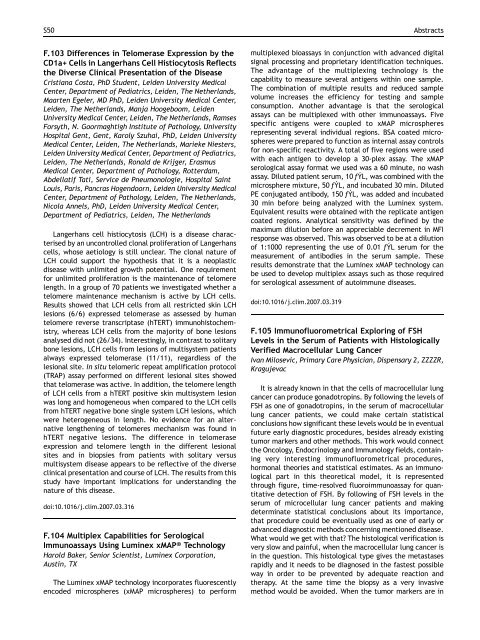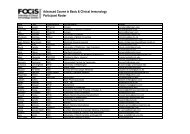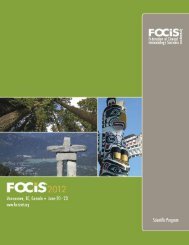Oral Presentations - Federation of Clinical Immunology Societies
Oral Presentations - Federation of Clinical Immunology Societies
Oral Presentations - Federation of Clinical Immunology Societies
You also want an ePaper? Increase the reach of your titles
YUMPU automatically turns print PDFs into web optimized ePapers that Google loves.
S50 Abstracts<br />
F.103 Differences in Telomerase Expression by the<br />
CD1a+ Cells in Langerhans Cell Histiocytosis Reflects<br />
the Diverse <strong>Clinical</strong> Presentation <strong>of</strong> the Disease<br />
Cristiana Costa, PhD Student, Leiden University Medical<br />
Center, Department <strong>of</strong> Pediatrics, Leiden, The Netherlands,<br />
Maarten Egeler, MD PhD, Leiden University Medical Center,<br />
Leiden, The Netherlands, Manja Hoogeboom, Leiden<br />
University Medical Center, Leiden, The Netherlands, Ramses<br />
Forsyth, N. Goormaghtigh Institute <strong>of</strong> Pathology, University<br />
Hospital Gent, Gent, Karoly Szuhai, PhD, Leiden University<br />
Medical Center, Leiden, The Netherlands, Marieke Niesters,<br />
Leiden University Medical Center, Department <strong>of</strong> Pediatrics,<br />
Leiden, The Netherlands, Ronald de Krijger, Erasmus<br />
Medical Center, Department <strong>of</strong> Pathology, Rotterdam,<br />
Abdellatif Tati, Service de Pneumonologie, Hospital Saint<br />
Louis, Paris, Pancras Hogendoorn, Leiden University Medical<br />
Center, Department <strong>of</strong> Pathology, Leiden, The Netherlands,<br />
Nicola Annels, PhD, Leiden University Medical Center,<br />
Department <strong>of</strong> Pediatrics, Leiden, The Netherlands<br />
Langerhans cell histiocytosis (LCH) is a disease characterised<br />
by an uncontrolled clonal proliferation <strong>of</strong> Langerhans<br />
cells, whose aetiology is still unclear. The clonal nature <strong>of</strong><br />
LCH could support the hypothesis that it is a neoplastic<br />
disease with unlimited growth potential. One requirement<br />
for unlimited proliferation is the maintenance <strong>of</strong> telomere<br />
length. In a group <strong>of</strong> 70 patients we investigated whether a<br />
telomere maintenance mechanism is active by LCH cells.<br />
Results showed that LCH cells from all restricted skin LCH<br />
lesions (6/6) expressed telomerase as assessed by human<br />
telomere reverse transcriptase (hTERT) immunohistochemistry,<br />
whereas LCH cells from the majority <strong>of</strong> bone lesions<br />
analysed did not (26/34). Interestingly, in contrast to solitary<br />
bone lesions, LCH cells from lesions <strong>of</strong> multisystem patients<br />
always expressed telomerase (11/11), regardless <strong>of</strong> the<br />
lesional site. In situ telomeric repeat amplification protocol<br />
(TRAP) assay performed on different lesional sites showed<br />
that telomerase was active. In addition, the telomere length<br />
<strong>of</strong> LCH cells from a hTERT positive skin multisystem lesion<br />
was long and homogeneous when compared to the LCH cells<br />
from hTERT negative bone single system LCH lesions, which<br />
were heterogeneous in length. No evidence for an alternative<br />
lengthening <strong>of</strong> telomeres mechanism was found in<br />
hTERT negative lesions. The difference in telomerase<br />
expression and telomere length in the different lesional<br />
sites and in biopsies from patients with solitary versus<br />
multisystem disease appears to be reflective <strong>of</strong> the diverse<br />
clinical presentation and course <strong>of</strong> LCH. The results from this<br />
study have important implications for understanding the<br />
nature <strong>of</strong> this disease.<br />
doi:10.1016/j.clim.2007.03.316<br />
F.104 Multiplex Capabilities for Serological<br />
Immunoassays Using Luminex xMAP ® Technology<br />
Harold Baker, Senior Scientist, Luminex Corporation,<br />
Austin, TX<br />
The Luminex xMAP technology incorporates fluorescently<br />
encoded microspheres (xMAP microspheres) to perform<br />
multiplexed bioassays in conjunction with advanced digital<br />
signal processing and proprietary identification techniques.<br />
The advantage <strong>of</strong> the multiplexing technology is the<br />
capability to measure several antigens within one sample.<br />
The combination <strong>of</strong> multiple results and reduced sample<br />
volume increases the efficiency for testing and sample<br />
consumption. Another advantage is that the serological<br />
assays can be multiplexed with other immunoassays. Five<br />
specific antigens were coupled to xMAP microspheres<br />
representing several individual regions. BSA coated microspheres<br />
were prepared to function as internal assay controls<br />
for non-specific reactivity. A total <strong>of</strong> five regions were used<br />
with each antigen to develop a 30-plex assay. The xMAP<br />
serological assay format we used was a 60 minute, no wash<br />
assay. Diluted patient serum, 10 ƒÝL, was combined with the<br />
microsphere mixture, 50 ƒÝL, and incubated 30 min. Diluted<br />
PE conjugated antibody, 150 ƒÝL, was added and incubated<br />
30 min before being analyzed with the Luminex system.<br />
Equivalent results were obtained with the replicate antigen<br />
coated regions. Analytical sensitivity was defined by the<br />
maximum dilution before an appreciable decrement in MFI<br />
response was observed. This was observed to be at a dilution<br />
<strong>of</strong> 1:1000 representing the use <strong>of</strong> 0.01 ƒÝL serum for the<br />
measurement <strong>of</strong> antibodies in the serum sample. These<br />
results demonstrate that the Luminex xMAP technology can<br />
be used to develop multiplex assays such as those required<br />
for serological assessment <strong>of</strong> autoimmune diseases.<br />
doi:10.1016/j.clim.2007.03.319<br />
F.105 Immun<strong>of</strong>luorometrical Exploring <strong>of</strong> FSH<br />
Levels in the Serum <strong>of</strong> Patients with Histologically<br />
Verified Macrocellular Lung Cancer<br />
Ivan Milosevic, Primary Care Physician, Dispensary 2, ZZZZR,<br />
Kragujevac<br />
It is already known in that the cells <strong>of</strong> macrocellular lung<br />
cancer can produce gonadotropins. By following the levels <strong>of</strong><br />
FSH as one <strong>of</strong> gonadotropins, in the serum <strong>of</strong> macrocellular<br />
lung cancer patients, we could make certain statistical<br />
conclusions how significant these levels would be in eventual<br />
future early diagnostic procedures, besides already existing<br />
tumor markers and other methods. This work would connect<br />
the Oncology, Endocrinology and <strong>Immunology</strong> fields, containing<br />
very interesting immun<strong>of</strong>luorometrical procedures,<br />
hormonal theories and statistical estimates. As an immunological<br />
part in this theoretical model, it is represented<br />
through figure, time-resolved fluoroimmunoassay for quantitative<br />
detection <strong>of</strong> FSH. By following <strong>of</strong> FSH levels in the<br />
serum <strong>of</strong> microcellular lung cancer patients and making<br />
determinate statistical conclusions about its importance,<br />
that procedure could be eventually used as one <strong>of</strong> early or<br />
advanced diagnostic methods concerning mentioned disease.<br />
What would we get with that? The histological verification is<br />
very slow and painful, when the macrocellular lung cancer is<br />
in the question. This histological type gives the metastases<br />
rapidly and it needs to be diagnosed in the fastest possible<br />
way in order to be prevented by adequate reaction and<br />
therapy. At the same time the biopsy as a very invasive<br />
method would be avoided. When the tumor markers are in




